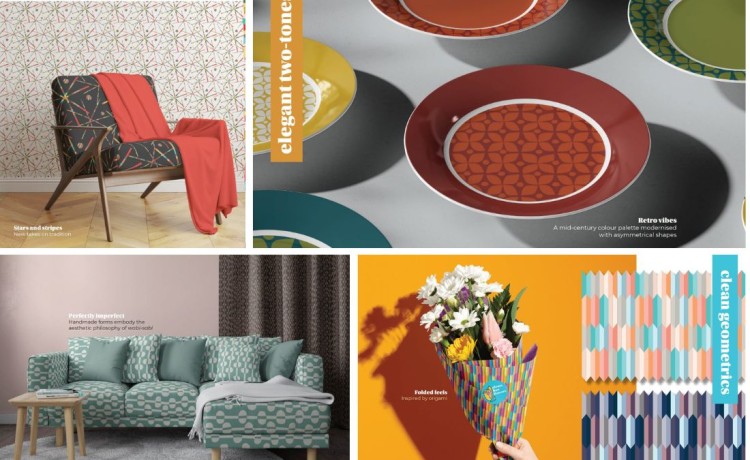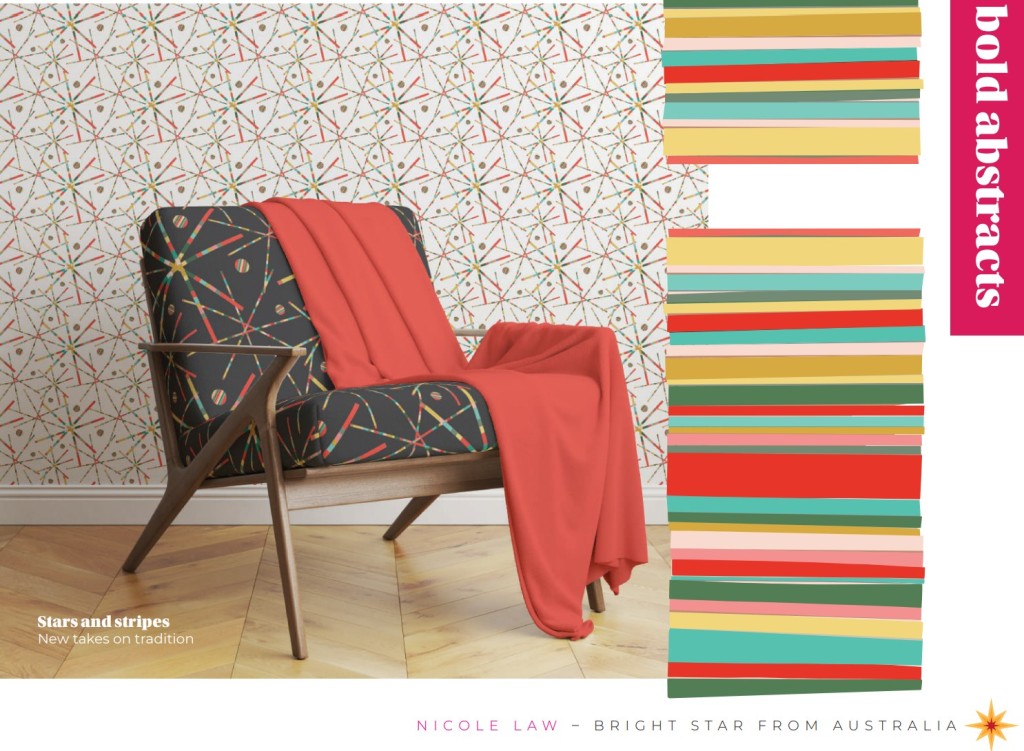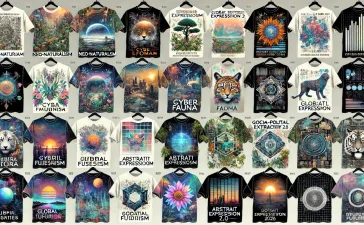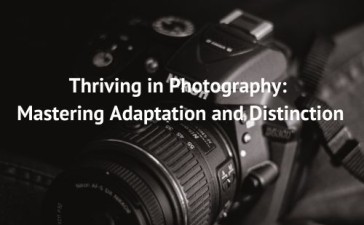A Retro Revolution in Design by Niclo Law
The 1950s and 1960s were iconic decades that left a lasting mark on design, especially in fashion, interior decor, and graphic arts. The bold, playful aesthetics of these eras have seen a resurgence in recent years, especially among artists and designers looking to tap into nostalgia while simultaneously offering a fresh take on retro styles. Patterns from the 1950s and 1960s evoke a sense of optimism, simplicity, and vibrancy—qualities that still resonate with modern audiences.
This article will explore some of the most popular patterns from these decades and how designers can reinterpret them for contemporary projects. By fusing the retro charm of mid-century design with modern sensibilities, artists can create timeless yet innovative works that appeal to today’s market.
1950s and 1960s Inspired patterns by Nicole Law
Popular Patterns from the 1950s and 1960s
The 1950s and 1960s were defined by a distinctive visual language, with patterns that ranged from geometric abstractions to playful, whimsical motifs. Here are some of the most influential patterns from the period:
- Atomic Age Motifs: Inspired by the space race and scientific advancements, atomic patterns featured abstract shapes like starbursts, boomerangs, and molecules. These motifs were often combined with bold color palettes, reflecting a sense of futuristic optimism.
- Geometric Shapes: The simplicity and versatility of geometric patterns made them a hallmark of mid-century design. Bold squares, circles, diamonds, and hexagons in repeating arrangements dominated fabrics, wallpapers, and home decor.
- Plaid and Checkered Patterns: Plaid, gingham, and checkered designs were popular in the 1950s, particularly in fashion and home textiles. These patterns often used traditional colours like red, black, and white, though contemporary iterations may experiment with more vibrant hues.
- Floral and Botanical Prints: The 1960s saw a rise in vibrant floral patterns, often with exaggerated, stylized blooms. These prints appeared on everything from wallpaper to dresses and were closely associated with the counterculture movement of the late 1960s.
- Polka Dots: Simple yet playful, polka dots were a uin both fashion and home decor during the 1950s. They were often paired with other retro motifs like bows and ribbons.
- Retro Typography: Typography in the 1950s and 1960s often featured playful, hand-drawn fonts that exuded personality. Think vintage diner signage, advertising copy, and comic book lettering. This typography often employed thick, rounded lettering, making it highly readable and visually impactful.
- Abstract Art Prints: Drawing on the influences of abstract expressionism, designers of the 1960s embraced abstract art prints featuring freeform shapes, bold splashes of colour, and asymmetrical compositions. These designs added a sense of artistic rebellion to everyday objects.
- Pop Art and Comic Book Prints: With the rise of pop art in the 1960s, designs began incorporating graphic, comic book-style illustrations. Bold outlines, halftone dots, and bright primary colors were popularized by artists like Roy Lichtenstein and Andy Warhol.
- Mod Circles and Ovals: The mod movement of the 1960s embraced clean, minimalist shapes like circles and ovals, often used in bold, high-contrast colour schemes. These patterns are frequently seen in fashion, textiles, and interior design.
- Chevron Patterns: Zigzag or chevron patterns became popular in the late 1950s and early 1960s, adding dynamic movement and energy to fashion, wallpaper, and flooring. This pattern remains a staple in modern design.
Star & Stripes_Retro Patterns by Nicole Law
How Artists and Designers Can Use Retro-Inspired Patterns
For artists and designers, patterns inspired by the 1950s and 1960s provide endless opportunities to blend nostalgia with contemporary trends. Here are a few ways to reinterpret these retro motifs for modern audiences:
- Revitalize Atomic Age Motifs: While atomic patterns can easily evoke a sense of nostalgia, updating the color palette can bring them into the modern age. Consider replacing the muted pastels of the 1950s with bold neon or metallic accents for a futuristic twist.
- Geometric Patterns in New Contexts: Geometric designs are timeless and can be adapted to a variety of settings. Think beyond the traditional use of these patterns in wallpaper and textiles; experiment with incorporating geometric shapes into product packaging, web design, or even urban art.
- Reinvent Plaid and Checkered Patterns: While plaid and gingham patterns may evoke the 1950s, designers can experiment with modern colors and textures to update this classic look. Consider using plaid in unconventional hues like neon green, hot pink, or metallic silver to appeal to a contemporary audience.
- Bold Florals for Modern Applications: The exaggerated floral prints of the 1960s can be made contemporary by playing with scale and color. Oversized flowers in abstract arrangements could appear on modern upholstery or as statement wallpaper in minimalist interiors.
- Retro Typography for Branding: Vintage-inspired typography is an excellent choice for businesses or products seeking to evoke a sense of nostalgia. Use hand-drawn fonts for logos, posters, or packaging, but experiment with color gradients or 3D effects to keep the designs fresh and engaging.
- Mod Circles and Ovals with a Twist: Mod patterns can be easily updated with a minimalist approach, using bold, solid colors, and negative space. Designers can apply these patterns to textiles, digital platforms, or even interior decor to give a nod to retro style without feeling dated.
- Chevron in Unexpected Colors: Chevron is a versatile pattern that can be adapted to modern sensibilities by playing with color and texture. Try using metallic or gradient hues to give the pattern a sleek, modern edge, perfect for fashion or interior accessories.
- Polka Dots with a New Spin: Polka dots can be playful and quirky, making them perfect for product packaging, apparel, and graphic design. Instead of the traditional black-and-white dots, experiment with irregular dot sizes or metallic finishes for a fresh take.
- Abstract Art Patterns for Interiors: Abstract prints lend themselves well to contemporary home decor. Whether you’re designing throw pillows, rugs, or wall art, bold abstract patterns can provide visual interest and a sense of movement.
- Pop Art Revival: Pop art’s influence on the 1960s is undeniable. Designers can bring this playful, comic-inspired aesthetic into the modern era by using it for limited-edition clothing collections, art prints, or marketing campaigns.
10 to 20 Pattern Prompts Inspired by the 1950s and 1960s
For designers looking to get inspired, here are some pattern prompts that pay homage to the 1950s and 1960s:
- Atomic Starburst: Create a pattern inspired by mid-century atomic designs featuring starburst shapes and molecular motifs.
- Retro Boomerangs: Use abstract boomerang shapes in repeating patterns, reminiscent of 1950s Formica tabletops.
- Mod Circles: Design a high-contrast circular pattern using bold colors like black, white, and red.
- Plaid with Metallic Accents: Reinvent a classic plaid pattern by incorporating metallic threads or digital accents for a modern edge.
- Oversized Floral Blooms: Create a bold floral pattern with oversized, stylized flowers, reminiscent of 1960s wallpaper.
- Chevron with Gradient Colors: Develop a chevron pattern with gradient color transitions, from pastel to neon.
- Pop Art Comics: Use comic book-style illustrations with halftone dots and speech bubbles in a repeating pattern.
- Polka Dots with a Twist: Create an irregular polka dot pattern in varying sizes, mixing metallic finishes with bright neon.
- Retro Typography: Use hand-drawn, retro-inspired fonts in a repeating pattern, paired with graphic elements like arrows or stars.
- Abstract Geometric: Design a bold, abstract geometric pattern using asymmetrical shapes in bright, contrasting colors.
- Vintage Baubles: Create a pattern with vintage-style holiday ornaments, using bright colors and metallic finishes.
- Stylized Reindeer: Use stylized reindeer illustrations in a repeating holiday pattern, blending mid-century whimsy with modern color schemes.
- Mid-Century Modern Leaves: Design a pattern inspired by mid-century modern plant motifs, with abstract leaves and stems.
- Checkerboard with a Twist: Reinvent the classic checkerboard pattern using unexpected colors like navy, lavender, or metallic gold.
- Scandinavian Folk Art: Incorporate Scandinavian-inspired folk art motifs into a repeating pattern, featuring symmetrical shapes and floral elements.
- Retro Appliances: Create a playful pattern featuring vintage kitchen appliances like blenders, toasters, and coffee pots.
- Stylized Raindrops: Use teardrop or raindrop shapes in a repeating pattern with soft, muted colors.
- Funky Fruit: Design a retro fruit pattern with stylized cherries, bananas, and oranges, drawing inspiration from vintage packaging.
- Mid-Century Landscapes: Create a stylized landscape pattern featuring abstract hills, trees, and clouds in soft, earthy tones.
- Neon Grids: Design a retro-inspired grid pattern using bright neon lines against a dark background for a futuristic look.
By using these prompts, artists and designers can breathe new life into iconic 1950s and 1960s patterns, blending nostalgia with modern design trends to create timeless yet fresh works for today’s market.
- Find out more
- Launch Pad + Accelerator Expressions of Interest
- Selling and Licensing Your Art & Designs Around the World with ArtSHINE.
- Looking for exciting new Art and Designs to license.
We’re here to help you to take action, just like we’ve helped thousands of other entrepreneurs, business owners, and creative professionals all around the globe.
Now is the time to let your passion SHINE.
Now is the time to Make Tomorrow Today!
To your success, Vinh Van Lam and Stuart Horrex Cofounders ArtSHINE.com







